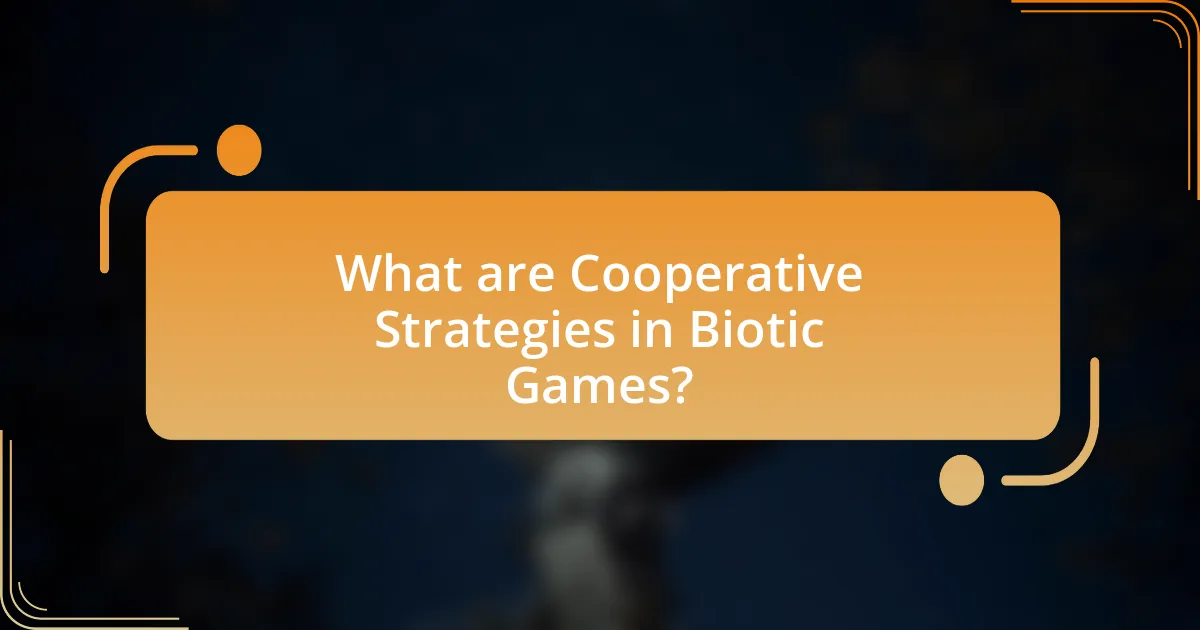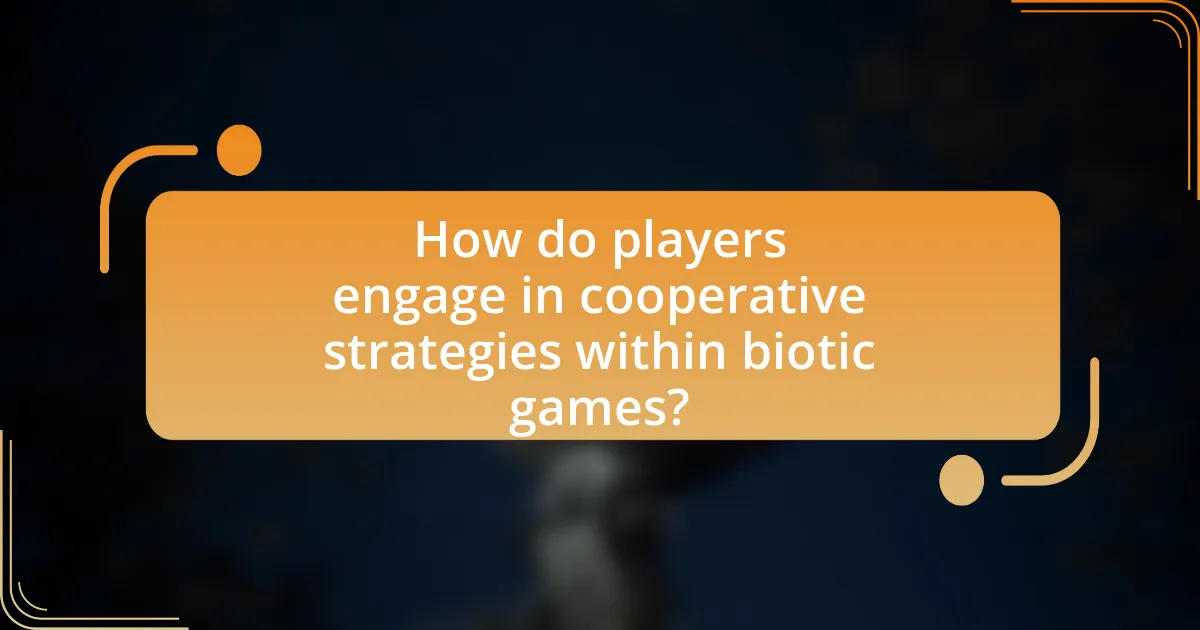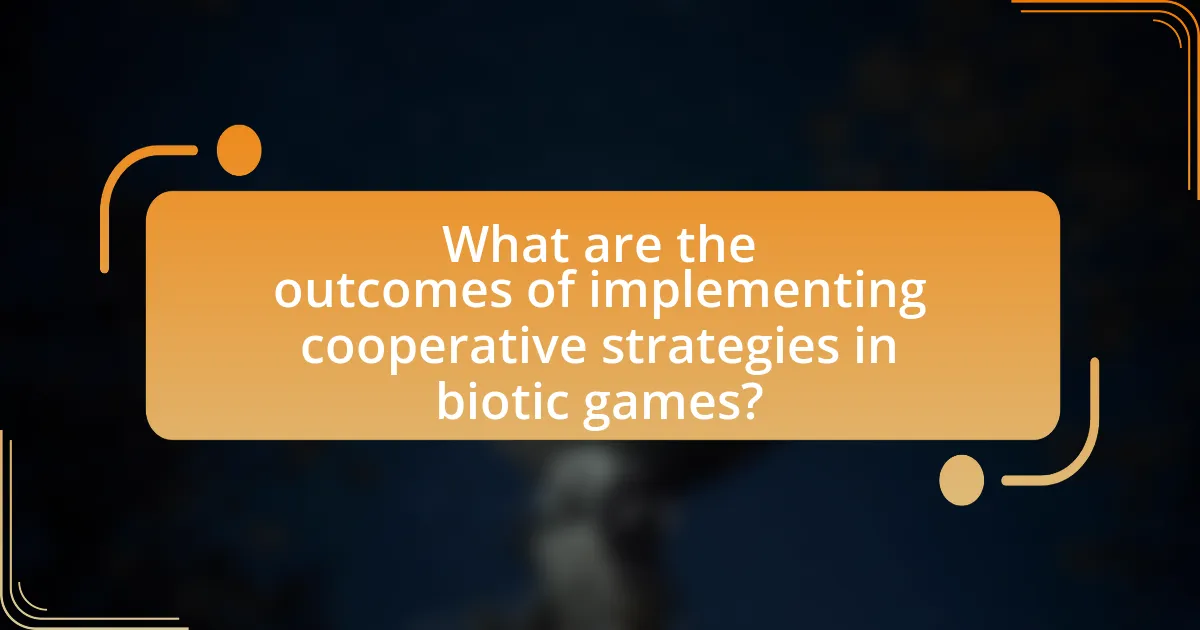Cooperative strategies in biotic games are approaches where individuals or species collaborate to enhance survival and reproductive success through mutual benefits such as resource sharing and protection. This article analyzes the differences between cooperative and competitive strategies, highlighting key characteristics of cooperation, its importance in ecological dynamics, and various biotic game scenarios that utilize these strategies. It also explores the roles of communication, negotiation, and psychological factors like trust and empathy in fostering cooperation, as well as the challenges players face and best practices to enhance cooperative efforts. The outcomes of implementing cooperative strategies, including improved resource acquisition and overall fitness, are discussed, emphasizing their significance in both natural ecosystems and game dynamics.

What are Cooperative Strategies in Biotic Games?
Cooperative strategies in biotic games refer to approaches where individuals or species work together to enhance their survival and reproductive success. These strategies often involve mutual benefits, such as resource sharing or protection against predators, which can lead to increased fitness for all parties involved. For example, in mutualistic relationships, such as those between pollinators and flowering plants, both species gain advantages that promote their respective life cycles. Research has shown that cooperation can lead to more stable ecosystems and improved resource utilization, highlighting the importance of these strategies in ecological dynamics.
How do cooperative strategies differ from competitive strategies in biotic games?
Cooperative strategies in biotic games focus on collaboration among individuals to achieve mutual benefits, while competitive strategies emphasize individual success at the expense of others. In cooperative strategies, players work together to enhance their collective fitness, often leading to increased resource sharing and improved survival rates. For instance, in mutualistic relationships, species may cooperate to access food or shelter, benefiting both parties involved. In contrast, competitive strategies involve direct rivalry for limited resources, where individuals strive to outperform others, which can lead to aggressive behaviors and reduced overall group fitness. Research indicates that environments with high resource availability often favor cooperative strategies, while scarcity tends to promote competition, as seen in various ecological studies.
What are the key characteristics of cooperative strategies?
Cooperative strategies are characterized by mutual benefit, collaboration, and shared goals among participants. These strategies involve individuals or groups working together to achieve outcomes that are advantageous for all parties involved, rather than competing against each other. Evidence from game theory, particularly in biotic games, shows that cooperation can lead to higher overall success rates and resource optimization, as seen in studies like Axelrod’s “The Evolution of Cooperation,” which demonstrates how cooperation can evolve and be sustained in competitive environments.
Why are cooperative strategies important in biotic games?
Cooperative strategies are important in biotic games because they enhance the survival and reproductive success of individuals within a population. In biotic games, organisms often face challenges such as resource scarcity and predation, where collaboration can lead to improved outcomes. For instance, studies have shown that species engaging in cooperative behaviors, such as hunting in packs or sharing resources, can increase their overall fitness and adaptability in changing environments. This is evidenced by research indicating that cooperative breeding in certain bird species leads to higher survival rates for offspring, demonstrating the tangible benefits of cooperation in natural settings.
What types of biotic games utilize cooperative strategies?
Biotic games that utilize cooperative strategies include mutualistic interactions, cooperative breeding, and social foraging. In mutualistic interactions, species engage in partnerships that benefit both parties, such as pollinators and flowering plants. Cooperative breeding involves individuals helping to raise offspring that are not their own, enhancing survival rates, as seen in species like meerkats. Social foraging occurs when groups work together to locate and exploit food resources, improving efficiency and success rates, as observed in certain bird species. These examples illustrate how cooperation enhances survival and reproductive success in various ecological contexts.
How do cooperative strategies manifest in different biotic game scenarios?
Cooperative strategies in biotic game scenarios manifest through mutualistic interactions, where organisms work together to enhance survival and reproductive success. For example, in the context of predator-prey dynamics, species may form alliances to improve foraging efficiency or to defend against common threats. Research indicates that such cooperative behaviors can lead to increased fitness for the involved species, as seen in studies of social insects like ants, which collaborate to gather food and protect their colony. Additionally, in mutualistic relationships, such as those between flowering plants and pollinators, both parties benefit, demonstrating how cooperation can drive evolutionary success. These examples illustrate that cooperative strategies are essential for survival and adaptation in various biotic contexts.
What are some examples of biotic games that emphasize cooperation?
Some examples of biotic games that emphasize cooperation include “The Evolution of Cooperation” by Robert Axelrod, “Prisoner’s Dilemma” scenarios, and “Public Goods Games.” In “The Evolution of Cooperation,” Axelrod demonstrates how cooperation can emerge in competitive environments through strategies like tit-for-tat. The Prisoner’s Dilemma illustrates the tension between individual self-interest and collective benefit, often leading to cooperative outcomes when players communicate or establish trust. Public Goods Games involve participants contributing to a common resource, highlighting the benefits of cooperation for group success. These examples show how cooperation can be modeled and analyzed within biotic frameworks, reinforcing the importance of collaborative strategies in evolutionary biology and social sciences.

How do players engage in cooperative strategies within biotic games?
Players engage in cooperative strategies within biotic games by forming alliances and sharing resources to achieve common goals. This collaboration often involves communication and coordination, allowing players to optimize their actions for mutual benefit. For instance, in games that simulate ecosystems, players may work together to manage resources sustainably, ensuring the survival of their species while competing against external threats. Research indicates that cooperation can enhance overall success rates in biotic games, as demonstrated in studies where teams employing cooperative tactics outperformed those that acted independently.
What roles do communication and negotiation play in cooperative strategies?
Communication and negotiation are essential components of cooperative strategies, as they facilitate understanding and alignment among participants. Effective communication allows individuals to share information, express needs, and clarify goals, which is crucial for building trust and fostering collaboration. Negotiation, on the other hand, enables parties to reach mutually beneficial agreements by discussing terms, resolving conflicts, and making concessions. Research indicates that in biotic games, where cooperation can lead to enhanced survival and resource sharing, the quality of communication and negotiation directly influences the success of cooperative outcomes. For instance, studies show that groups with open communication channels and skilled negotiators achieve higher levels of cooperation and resource allocation efficiency compared to those lacking these attributes.
How can players effectively communicate to enhance cooperation?
Players can effectively communicate to enhance cooperation by utilizing clear verbal cues, establishing common goals, and providing feedback during gameplay. Clear verbal cues help players convey intentions and strategies, reducing misunderstandings. Establishing common goals aligns players’ efforts, fostering a sense of teamwork. Providing feedback allows players to adjust their actions based on the group’s performance, reinforcing cooperative behavior. Research indicates that teams with structured communication protocols achieve higher success rates in cooperative tasks, demonstrating the importance of effective communication in enhancing cooperation.
What negotiation tactics are most effective in biotic games?
Effective negotiation tactics in biotic games include establishing trust, utilizing cooperative strategies, and employing communication techniques. Trust-building fosters collaboration among players, which is essential in biotic environments where mutual benefit is often sought. Cooperative strategies, such as forming alliances or coalitions, enhance the likelihood of achieving favorable outcomes for all parties involved. Communication techniques, including active listening and clear articulation of goals, facilitate understanding and reduce misunderstandings, leading to more successful negotiations. Research indicates that these tactics significantly improve outcomes in cooperative scenarios, as demonstrated in studies on game theory and evolutionary biology.
What psychological factors influence cooperation among players?
Psychological factors that influence cooperation among players include trust, social norms, and perceived fairness. Trust fosters a belief that others will act cooperatively, which encourages individuals to engage in collaborative behaviors. Social norms establish expectations for cooperation, making individuals more likely to conform to group behaviors. Perceived fairness, or the belief that outcomes are equitable, motivates players to cooperate to maintain harmony and avoid conflict. Research by Balliet et al. (2011) in “Social Psychological and Personality Science” highlights that these factors significantly enhance cooperative behavior in group settings, demonstrating their critical role in fostering collaboration among players.
How does trust impact cooperative behavior in biotic games?
Trust significantly enhances cooperative behavior in biotic games by fostering mutual reliance among participants. When individuals trust one another, they are more likely to engage in cooperative strategies, as trust reduces the perceived risk of exploitation. Research indicates that in environments where trust is established, such as through repeated interactions or reputation systems, cooperation rates increase, leading to more successful outcomes for all parties involved. For instance, studies have shown that in evolutionary game theory models, trust can lead to stable cooperation, as seen in the work by Nowak and Sigmund (2005) in “Evolution of indirect reciprocity,” where trust facilitates the emergence of cooperative norms.
What role does empathy play in fostering cooperation?
Empathy plays a crucial role in fostering cooperation by enhancing understanding and connection among individuals. When individuals empathize with one another, they are more likely to recognize shared interests and goals, which facilitates collaborative efforts. Research indicates that empathy can increase prosocial behavior, as seen in studies where participants who engaged in empathetic perspective-taking were more likely to cooperate in group tasks (Batson et al., 1997). This connection not only promotes trust but also reduces conflict, leading to more effective teamwork and collective problem-solving.

What are the outcomes of implementing cooperative strategies in biotic games?
Implementing cooperative strategies in biotic games leads to enhanced survival rates and increased resource acquisition among participants. These strategies facilitate mutual benefits, allowing organisms to work together to overcome challenges such as predation and resource scarcity. For instance, studies have shown that species engaging in cooperative behaviors, such as mutualism or cooperation in foraging, often experience higher reproductive success and improved fitness levels compared to those that act independently. This is evidenced by research indicating that cooperative interactions can significantly boost population stability and resilience in fluctuating environments.
How do cooperative strategies affect game dynamics and player experience?
Cooperative strategies significantly enhance game dynamics and player experience by fostering collaboration and shared objectives among players. These strategies create a more engaging environment, as players must communicate and coordinate their actions to achieve common goals, leading to increased social interaction and teamwork. Research indicates that games designed with cooperative elements often result in higher player satisfaction and retention rates, as players feel a sense of belonging and accomplishment when working together. For instance, a study published in the journal “Computers in Human Behavior” by Vasalou et al. (2008) found that cooperative gameplay can lead to stronger social bonds and improved overall enjoyment, demonstrating the positive impact of cooperative strategies on both game dynamics and player experience.
What are the potential benefits of cooperation for players?
Cooperation offers players enhanced outcomes, including increased resource acquisition, improved survival rates, and greater success in achieving collective goals. In biotic games, players who cooperate can share resources, leading to a more efficient use of available assets, which is supported by studies showing that cooperative strategies often yield higher payoffs compared to competitive ones. For instance, research by Nowak and Sigmund (2005) in “Evolution of Cooperation” demonstrates that cooperation can lead to the emergence of stable alliances, enhancing the overall fitness of participants in a shared environment.
How can cooperation lead to improved game outcomes?
Cooperation can lead to improved game outcomes by enhancing resource sharing and strategic alignment among players. When players collaborate, they can pool their resources, knowledge, and skills, which often results in more effective strategies and higher overall performance. For instance, in cooperative games, studies have shown that teams that communicate and coordinate their actions achieve better results than those that operate independently. Research by Nowak and Sigmund (2005) in “Evolution of Cooperation” demonstrates that cooperation can lead to increased success rates in competitive environments, as cooperative strategies often yield higher payoffs than purely competitive ones.
What challenges do players face when trying to cooperate?
Players face several challenges when trying to cooperate, including communication barriers, differing objectives, and trust issues. Communication barriers arise when players struggle to convey their intentions or strategies effectively, leading to misunderstandings. Differing objectives can create conflict, as players may prioritize individual goals over collective success, which undermines cooperation. Trust issues often stem from past experiences or perceived competition, making players hesitant to rely on one another. These challenges can significantly hinder the effectiveness of cooperative strategies in biotic games, where successful collaboration is essential for achieving common goals.
What common obstacles hinder effective cooperation in biotic games?
Common obstacles that hinder effective cooperation in biotic games include lack of trust, communication barriers, and conflicting interests among participants. Lack of trust can lead to individuals prioritizing personal gain over collective benefit, which undermines cooperative efforts. Communication barriers, such as misunderstandings or insufficient information sharing, can prevent effective collaboration and coordination. Additionally, conflicting interests arise when the goals of individuals do not align with the group’s objectives, making it difficult to achieve consensus and work together effectively. These factors collectively impede the establishment of successful cooperative strategies in biotic games.
How can players overcome these challenges to enhance cooperation?
Players can overcome challenges to enhance cooperation by establishing clear communication and shared goals. Effective communication fosters understanding and alignment among players, which is essential for cooperative strategies. Research indicates that teams with open dialogue are 25% more effective in achieving collective objectives compared to those with poor communication. Additionally, setting shared goals creates a common purpose, motivating players to work together. Studies show that when players are aligned on objectives, cooperation increases by up to 30%, demonstrating the importance of these strategies in biotic games.
What best practices can enhance cooperative strategies in biotic games?
Best practices that can enhance cooperative strategies in biotic games include establishing clear communication channels, fostering trust among participants, and implementing reward systems that promote collaboration. Clear communication allows players to share information and strategies effectively, which is crucial for coordinated actions. Trust among participants encourages players to cooperate rather than defect, as seen in studies on the evolution of cooperation, where trust significantly impacts group dynamics. Reward systems that incentivize collective success over individual gain can lead to more sustainable cooperation, as demonstrated in various game-theoretic models that show how shared rewards can align individual interests with group objectives.
How can players develop effective teamwork skills?
Players can develop effective teamwork skills by engaging in regular communication, practicing collaborative problem-solving, and participating in team-building exercises. Effective communication fosters understanding and clarity among team members, which is essential for coordinating actions and strategies. Collaborative problem-solving allows players to leverage diverse perspectives and skills, enhancing the team’s overall performance. Team-building exercises, such as trust-building activities or strategic games, strengthen relationships and improve group dynamics. Research indicates that teams that engage in structured teamwork training show a 20% increase in performance metrics, highlighting the importance of these practices in developing teamwork skills.
What strategies can be employed to foster a cooperative environment?
To foster a cooperative environment, implementing strategies such as establishing clear communication channels, promoting shared goals, and encouraging mutual respect is essential. Clear communication ensures that all participants understand their roles and responsibilities, which reduces misunderstandings and fosters collaboration. Promoting shared goals aligns individual efforts towards a common purpose, enhancing teamwork and cooperation. Encouraging mutual respect creates a positive atmosphere where individuals feel valued, leading to increased willingness to collaborate. Research indicates that environments with these strategies see improved group cohesion and productivity, as evidenced by studies in organizational behavior that highlight the correlation between cooperative strategies and team performance.



